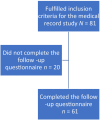Factors Influencing Adherence to Adjuvant Endocrine Therapy After Breast Cancer Surgery
- PMID: 39158164
- PMCID: PMC11331500
- DOI: 10.1002/cnr2.2160
Factors Influencing Adherence to Adjuvant Endocrine Therapy After Breast Cancer Surgery
Abstract
Background: Women with newly diagnosed hormone receptor-positive breast cancer are offered adjuvant endocrine therapy (AET). Despite the survival benefits of the therapy, a significant proportion of breast cancer patients do not adhere to the anti-hormonal medication.
Aims: The purpose of this study was to analyse demographic, social, psychological and treatment-related factors influencing whether women diagnosed with early-stage breast cancer were adherent to offered therapy.
Materials and methods: This was a long-term retrospective, medical record study, supplemented with a questionnaire, including 81 women. Data from the Swedish Prescribed Drug Register were used to examine adherence. The women were followed for 5 years of offered AET.
Results: Out of 81 women, 67 (83%) were adherent (hade taken out 80% or more of the recommended dose), 10 (12%) were Partially Adherent and 4 (5%) never accepted AET. At baseline, the Never-Adherent group members were younger, more often considered themselves healthy and seemed much more satisfied with their lives. Baseline factors that positively affected adherence were satisfaction with the vocational situation (p = 0.023) and satisfaction with family life (p = 0.040). Cumulative musculoskeletal side effects were more frequently reported among women in the Adherent group than Partially Adherent women, after both 12 and 60 months (p = 0.018 and p = 0.011, respectively). There was also a significant difference in reported cumulative psychological side effects (p = 0.049) in disfavour of the Adherent group. Moreover, according to the questionnaire where the women retrospectively were asked which side effects, they experienced during the treatment period; sexual desire was significantly lower in the Adherent group (p = 0.0402) than in the Partially Adherent group.
Conclusion: It is important to consider a woman's life situation, to support those who otherwise would not be able to complete AET and to help all women relieve side effects during AET. It should be investigated why some women did not start the recommended therapy.
Keywords: adherence; anti‐hormonal side effects; breast cancer; life satisfaction.
© 2024 The Author(s). Cancer Reports published by Wiley Periodicals LLC.
Conflict of interest statement
The authors declare no conflicts of interest.
Figures
References
-
- Dezentje V. O., van Blijderveen N. J., Gelderblom H., et al., “Effect of Concomitant CYP2D6 Inhibitor Use and Tamoxifen Adherence on Breast Cancer Recurrence in Early‐Stage Breast Cancer,” Journal of Clinical Oncology 28, no. 14 (2010): 2423–2429. - PubMed
-
- Owusu C., Buist D. S., Field T. S., et al., “Predictors of Tamoxifen Discontinuation Among Older Women With Estrogen Receptor‐Positive Breast Cancer,” Journal of Clinical Oncology: Official Journal of the American Society of Clinical Oncology 26, no. 4 (2008): 549–555. - PubMed
MeSH terms
Substances
Grants and funding
LinkOut - more resources
Full Text Sources
Medical





